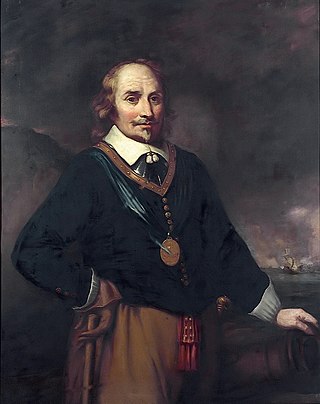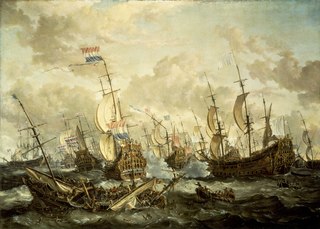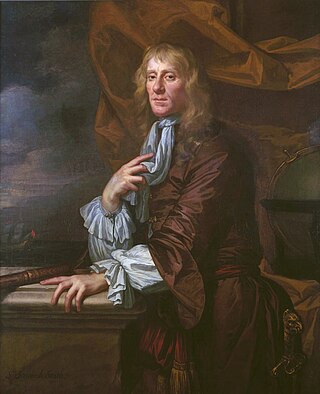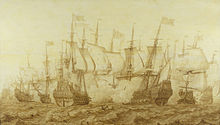
The First Anglo-Dutch War, or First Dutch War, was a naval conflict between the Commonwealth of England and Dutch Republic. Largely caused by disputes over trade, it began with English attacks on Dutch merchant shipping, but expanded to vast fleet actions. Despite a series of victories in 1652 and 1653, the Commonwealth was unable to blockade Dutch trade, although English privateers inflicted serious losses on Dutch merchant shipping.

Maarten Harpertszoon Tromp or Maarten van Tromp was a army general and admiral in the Dutch navy during much of the Eighty Years' War and throughout the First Anglo-Dutch War. Son of a ship's captain, Tromp spent much of his childhood at sea, during which time he was captured by pirates and enslaved by Barbary Corsairs. In adult life, he became a renowned ship captain and naval commander, successfully leading Dutch forces fighting for independence in the Eighty Years War, and then against England in the First Anglo-Dutch War, proving an innovative tactician and enabling the newly independent Dutch nation to become a major sea power. He was killed in battle by a sharpshooter from an English ship. Several ships of the Royal Netherlands Navy have carried the name HNLMS Tromp after him and/or his son Cornelis, also a Dutch Admiral of some renown.

The Anglo–Dutch Wars were a series of conflicts mainly fought between the Dutch Republic and England in the mid-17th and late 18th century. The first three wars occurred in the second half of the 17th century over trade and overseas colonies, while the fourth was fought a century later. Almost all the battles were naval engagements.

The Four Days' Battle was a naval engagement fought from 11 to 14 June 1666 during the Second Anglo-Dutch War. It began off the Flemish coast and ended near the English coast, and remains one of the longest naval battles in history.

The naval Battle of Dover, fought on 19 May 1652, was the first engagement of the First Anglo-Dutch War between the navies of the Commonwealth of England and the United Provinces of the Netherlands. It proved to be an indecisive battle involving the flagships of Admirals Maarten Tromp and Robert Blake. Opinions about the outcome of that battle vary among historians of that period.

The naval Battle of Portland, or Three Days' Battle, took place during 18–20 February 1653, during the First Anglo-Dutch War, when the fleet of the Commonwealth of England under General at Sea Robert Blake was attacked by a fleet of the Dutch Republic under Lieutenant-Admiral Maarten Tromp escorting merchant shipping through the English Channel.

The Battle of Scheveningen was the final naval battle of the First Anglo-Dutch War. It took place on 31 July 1653 between the fleets of the Commonwealth of England and the Dutch Republic. The Dutch fleet suffered heavy losses.

Robert Blake was an English naval officer who served as General at sea and the Lord Warden of the Cinque Ports from 1656 to 1657. Blake served under Oliver Cromwell during the English Civil War and Anglo-Spanish War, and as the commanding Admiral of the Dutch navy during the First Anglo-Dutch War. Blake is recognized as the "chief founder of England's naval supremacy", a dominance subsequently inherited by the British Royal Navy well into the early 20th century Despite this, due to deliberate attempts to expunge the Parliamentarians from historical records following the Stuart Restoration, Blake's achievements tend to remain relatively unrecognized. Blake's successes, however, are considered to have "never been excelled, not even by Nelson" according to one biographer, while Blake is often compared with Nelson by others.

Cornelis Maartenszoon Tromp, Count of Sølvesborg was a Dutch naval officer who served as lieutenant-admiral general in the Dutch Navy, and briefly as a general admiral in the Royal Danish-Norwegian Navy. Tromp fought in the Anglo-Dutch Wars and the Scanian War. His father was the renown Lieutenant Admiral Maarten Tromp.

The line of battle is a tactic in naval warfare in which a fleet of ships forms a line end to end. The first example of its use as a tactic is disputed—it has been variously claimed for dates ranging from 1502 to 1652. Line-of-battle tactics were in widespread use by 1675.

The Battle of the Kentish Knock was a naval battle between the fleets of the Dutch Republic and England, fought on 28 September 1652, during the First Anglo-Dutch War near the shoal called the Kentish Knock in the North Sea about thirty kilometres east of the mouth of the river Thames. The Dutch fleet, internally divided on political, regional and personal grounds, proved incapable of making a determined effort and was soon forced to withdraw, losing two ships and many casualties. In Dutch the action is called the Slag bij de Hoofden.

The naval Battle of Leghorn took place on 4 March 1653 , during the First Anglo-Dutch War, near Leghorn (Livorno), Italy. It was a victory of a Dutch squadron under Commodore Johan van Galen over an English squadron under Captain Henry Appleton. Afterwards, another English squadron under Captain Richard Badiley, which Appleton had been trying to join up with, reached the scene in time to observe the capture of the last ships of Appleton's squadron, but was outnumbered and forced to return to Porto Longone.

The naval Battle of Dungeness took place on 30 November 1652 during the First Anglo-Dutch War near the cape of Dungeness in Kent.

The Battles of Schooneveld were two naval battles of the Franco-Dutch War, fought off the coast of the Netherlands on 7 June and 14 June 1673 between an allied Anglo-French fleet commanded by Prince Rupert of the Rhine on his flagship the Royal Charles, and the fleet of the United Provinces, commanded by Michiel de Ruyter.

Abraham van der Hulst was a Dutch admiral in the 17th century.

Sir Jeremiah Smith was an officer of the Royal Navy who saw service during the First and Second Anglo-Dutch Wars, rising to the rank of admiral.
Vice-Admiral Sir Richard Stayner (1625–1662) was an English naval officer who supported the Parliamentary cause during the English Civil War and the Interregnum. During the First Anglo-Dutch War he commanded the Foresight in actions at Portland, the Gabbard and in the Battle of Scheveningen. During the Anglo-Spanish War (1654–1660), he won renown and a fortune in prize money when he captured a great part of the Spanish West Indian treasure fleet off Cadiz in 1656. He was knighted by the Lord Protector Oliver Cromwell for services in Admiral Robert Blake's destruction of Spanish ships at Santa Cruz, 1657. He was a rear-admiral of the fleet which brought Charles II to England in 1660. He was again knighted at the Restoration. He died at Lisbon, while serving as vice-admiral of the Mediterranean fleet.
The English ship Martin was a 14-gun sixth rate vessel built under the 1651 Programme at Portsmouth Dockyard for the Commonwealth of England in 1651/52. Her service in the Commonwealth Navy was very active. She participated in the Battles of Dover, Portland and the Gabbard. She was with Robert Blake at Porto Farina. She was the main vessel at the Capture of Jamaica in 1655. With the Restoration she became HMS Martin. During the Second Anglo-Dutch War she was in the initial battle of Lowestoft then the Battle of Vagen. She was sold in February 1667.


















